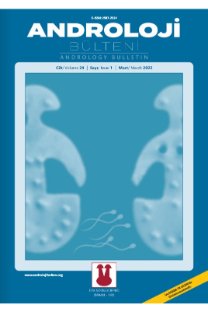Nonobstrüktif azoospermili erkeklerde mikrodiseksiyon testiküler sperm ekstraksiyonu başarısını etkileyen faktörler
Factors affecting the success of microdissection testicular sperm extraction in men with non-obstructive azoospermia
___
- 1. Schlegel PN, Li PS. Microdissection TESE. sperm retrieval in non-obstructive azoospermia. Hum Reprod Update 1998;4:439. [CrossRef]
- 2. Schlegel PN. Testicular sperm extraction: microdissection improves sperm yield with minimal tissue excision. Hum Reprod 1999;14:131–5. [CrossRef]
- 3. Bernie AM, Mata DA, Ramasamy R, Schlegel PN. Comparison of microdissection testicular sperm extraction, conventional testicular sperm extraction, and testicular sperm aspiration for nonobstructive azoospermia: a systematic review and meta-analysis. Fertil Steril 2015;104:1099–103.e3. [CrossRef]
- 4. Bernie AM, Ramasamy R, Schlegel PN. Predictive factors of successful microdissection testicular sperm extraction. Basic Clin Androl 2013;23:5. [CrossRef]
- 5. Ishikawa T. Surgical recovery of sperm in non-obstructive azoospermia. Asian J Androl 2012;14:109–15. [CrossRef]
- 6. Ramasamy R, Lin K, Gosden LV, Rosenwaks Z, Palermo GD, Schlegel PN. High serum FSH levels in men with nonobstructive azoospermia does not affect success of microdissection testicular sperm extraction. Fertil Steril 2009;92:590–3. [CrossRef]
- 7. Caroppo E, Colpi EM, Gazzano G, Vaccalluzzo L, Scroppo FI, D’Amato G, Colpi GM. Testicular histology may predict the successful sperm retrieval in patients with non-obstructive azoospermia undergoing conventional TESE. a diagnostic accuracy study. J Assist Reprod Genet 2017;34:149–54. [CrossRef]
- 8. Tash JA, Schlegel PN. Histologic effects of testicular sperm extraction on the testicle in men with nonobstructive azoospermia. Urology 2001;57:334–7. [CrossRef]
- 9. Bernie AM, Shah K, Halpern JA, Scovell J, Ramasamy R, Robinson B, Schlegel PN. Outcomes of microdissection testicular sperm extraction in men with nonobstructive azoospermia due to maturation arrest. Fertil Steril 2015;104:569–73. [CrossRef]
- 10. Abdel Raheem A, Garaffa G, Rushwan N, De Luca F, Zacharakis E, Abdel Raheem T, et al. Testicular histopathology as a predictor of a positive sperm retrieval in men with non-obstructive azoospermia. BJU Int 2013;111:492–9. [CrossRef]
- 11. Organization WHO. WHO laboratory manual for the examination and processing of human semen, 5th ed. Geneva: World Health Organization, Department of Reproductive Health and Research; 2010.
- 12. Flannigan R, Bach PV, Schlegel PN. Microdissection testicular sperm extraction. Transl Androl Urol 2017;6:745–52. [CrossRef]
- 13. Donoso P, Tournaye H, Devroey P. Which is the best sperm retrieval technique for non-obstructive azoospermia? A systematic review. Hum Reprod Update 2007;13:539–49. [CrossRef]
- 14. Bryson CF, Ramasamy R, Sheehan M, Palermo GD, Rosenwaks Z, Schlegel PN. Severe testicular atrophy does not affect the success of microdissection testicular sperm extraction. J Urol 2014;191:175– 8. [CrossRef]
- 15. Marconi M, Keudel A, Diemer T, Bergmann M, Steger K, Schuppe HC, Weidner W. Combined trifocal and microsurgical testicular sperm extraction is the best technique for testicular sperm retrieval in “low-chance” nonobstructive azoospermia. Eur Urol 2012;62:713–9. [CrossRef]
- 16. Bromage SJ, Falconer DA, Lieberman BA, Sangar V, Payne SR. Sperm retrieval rates in subgroups of primary azoospermic males. Eur Urol 2007;51:534–9. [CrossRef]
- 17. Ziaee SA, Ezzatnegad M, Nowroozi M, Jamshidian H, Abdi H, Hosseini Moghaddam SM. Prediction of successful sperm retrieval in patients with nonobstructive azoospermia. Urol J 2006;3:92–6. http://journals.sbmu.ac.ir/urolj/index.php/uj/article/view/202/200
- 18. Sofikitis N, Giotitsas N, Tsounapi P, Baltogiannis D, Giannakis D, Pardalidis N. Hormonal regulation of spermatogenesis and spermiogenesis. J Steroid Biochem Mol Biol 2008;109:323–30. [CrossRef]
- 19. Souza CA, Cunha Filho JS, Santos D, Gratao A, Freitas FM, Passos EP. Predictive factors for motile sperm recovery using testicular biopsy in nonobstructive azoospermic patients. Int Urol Nephrol 2003;35:53–7. [CrossRef]
- ISSN: 2587-2524
- Yayın Aralığı: 4
- Başlangıç: 1999
- Yayıncı: Turgay Arık
İnfertilitede unutulan bir kavram: Erkek cinselliği
IUI ve ICSI’de laboratuvar süreci
Prematür ejakülasyon tedavisinde güncel yaklaşımlar
İnfertil erkek populasyonda cinsel disfonksiyonun psikosomatik yansımaları
Çocuk ve yetişkinde onko-tese uygulamaları: 2019 güncelleme
A. Egemen AVCI, Mehmet Murad BASAR
Tek doz tadalafil 20 mg verildikten üç saat sonra idrar akım hızını arttırmaktadır
Zülfü SERTKAYA, Emre TOKUÇ, Kemal ERTAŞ
Saime ŞIK, Gülsemin ÇİÇEK, Fatma ÖZ BAĞCI, Emine UTLU ÖZEN, Selçuk DUMAN, Tahsin Murad AKTAN
4 mm’lik testis tümörüne ultrason eşliğinde işaretleme ile organ koruyucu cerrahi
Hakan Hakkı TAŞKAPU, Mehmet Giray SÖNMEZ, Gökhan ECER, Muzaffer Tansel KILINÇ, Süleyman BATDIK, Ahmet ÖZTÜRK
